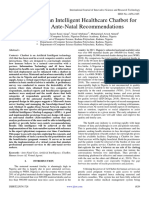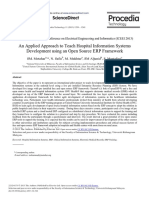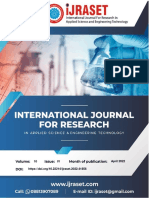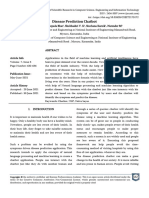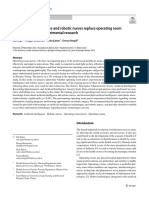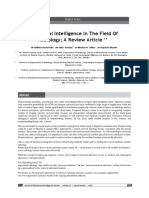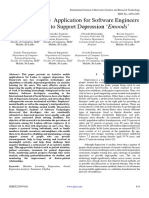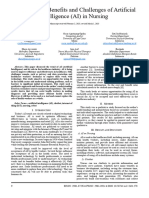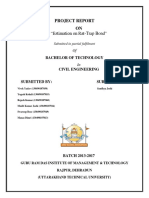Professional Documents
Culture Documents
A Chatbot System For Supporting Women and Families During Pregnancy
A Chatbot System For Supporting Women and Families During Pregnancy
Original Title
Copyright
Available Formats
Share this document
Did you find this document useful?
Is this content inappropriate?
Report this DocumentCopyright:
Available Formats
A Chatbot System For Supporting Women and Families During Pregnancy
A Chatbot System For Supporting Women and Families During Pregnancy
Copyright:
Available Formats
Volume 9, Issue 4, April – 2024 International Journal of Innovative Science and Research Technology
ISSN No:-2456-2165 https://doi.org/10.38124/ijisrt/IJISRT24APR697
A Chatbot System for Supporting Women and
Families during Pregnancy
1
Dr. P. Bhaskar
Professor, Dept. of CSE
QIS College of Engineering and Technology(A),
Ongole, Andhra Pradesh–523001, India
2 3
Tanuja Kunchala Srujana Peddi
Dept. of CSE Dept. of CSE
QIS College of Engineering and Technology(A), QIS College of Engineering and Technology(A),
Ongole, Andhra Pradesh–523001, India Ongole, Andhra Pradesh–523001, India
4 5
Rizwana Syed Pavani Namepalli
Dept. of CSE Dept. of CSE
QIS College of Engineering and Technology(A), QIS College of Engineering and Technology(A),
Ongole, Andhra Pradesh–523001, India Ongole, Andhra Pradesh–523001, India
Abstract:- PregBot is an innovative system that harnesses easily accessible healthcare solutions [1]. This paradigm shift
the power of machine learning (ML) and natural language holds profound implications for specialized areas like maternal
processing (NLP) to provide comprehensive support to and perinatal healthcare, which present unique challenges due
women and families throughout the pregnancy journey. to the intricate nature of care required and the diverse needs of
Recognizing the varying needs and challenges faced by patients [2]. Against this backdrop, our research introduces
expectant mothers, PregBot aims to revolutionize the "PregBot," an innovative system engineered to capitalize on the
maternal healthcare experience by offering personalized combined potential of ML and NLP to provide crucial support
guidance, real-time query resolution, and a virtual to pregnant women and their families [3].
community for support and connection. The system
leverages ML algorithms to analyze user data and tailor Pregnancy, while a time of great joy, is also characterized
responses, while NLP techniques enable natural language by uncertainties and obstacles. The availability of reliable,
interactions, allowing users to communicate with PregBot in personalized health information and emotional support during
a conversational manner. By continuously learning from this period is crucial, yet conventional healthcare systems often
user interactions, PregBot adapts and evolves, ensuring the struggle to meet these demands effectively [4]. Recognizing
delivery of timely and relevant information based on the this critical gap, PregBot is meticulously designed to offer
user's unique circumstances and stage of pregnancy. With comprehensive assistance, spanning from nutritional
its innovative approach to maternal healthcare, PregBot recommendations to mental health support, through the
represents a significant step towards empowering women, utilization of AI technologies to deliver tailored and
promoting positive pregnancy experiences, and contributing contextually relevant guidance [5]. PregBot leverages advanced
to the overall well-being of expectant mothers and their ML algorithms to analyze vast amounts of data, including
families. medical literature, clinical guidelines, and individual health
records, to provide evidence-based recommendations tailored to
Keywords:- Pregnancy, Machine Learning, Natural Language each user's specific needs and circumstances [6]. Through
Processing, Maternal Healthcare, Virtual Assistant. sophisticated NLP techniques, PregBot can engage in natural
language conversations with users, understanding their
I. INTRODUCTION inquiries, concerns, and preferences, and providing empathetic
and informative responses in return [7].
In the landscape of healthcare, the integration of Artificial
Intelligence (AI), particularly Machine Learning (ML) and One of the key strengths of PregBot lies in its ability to
Natural Language Processing (NLP), has emerged as a adapt and evolve alongside the user's journey through
transformative force, ushering in a new era of tailored and pregnancy. By continuously learning from user interactions and
IJISRT24APR697 www.ijisrt.com 522
Volume 9, Issue 4, April – 2024 International Journal of Innovative Science and Research Technology
ISSN No:-2456-2165 https://doi.org/10.38124/ijisrt/IJISRT24APR697
feedback, PregBot can refine its recommendations and support the potential of chatbots to provide effective support in this
strategies, ensuring that they remain relevant and effective context.
throughout the entire pregnancy and postpartum period [8].
This paper outlines the development of PregBot, its A lightweight mobile application aimed at providing
foundational technologies, and the unique approach it takes to maternity guidance, designed by M. Umme Kulsum et al. [8].
cater to the nuanced needs of pregnant women and their They consider the application's functionality and its potential
families [10]. benefits in offering assistance to pregnant mothers.
II. LITERATURE REVIEW The feasibility of a mental health chatbot and its impact on
postpartum health are examined by Suharwardy et al. [9] in
The study by Vaira et al. [1] examines MamaBot, a AJOG Global Reports. Their randomized controlled trial
sophisticated tool built on ML and NLP, designed to support evaluates the effectiveness of chatbot interventions in maternal
pregnant women and their families. This research explores the mental health.
potentials and mechanics of MamaBot in delivering
personalized care and guidance throughout pregnancy. Chung et al. [10] contribute to JMIR Medical Informatics
with their development and evaluation of a chatbot catering to
Mugoye et al. [2] contribute to the discourse on Smart-bot obstetric and mental health care for perinatal women and their
technology, focusing on its potential applications in maternal partners, underscoring the importance of digital tools in
healthcare. Their study examines the pivotal roles that supportive care.
conversational agents, or chatbots, could fulfill in supporting
expectant mothers. Kaneho et al. [11] conducted survey on existing healthcare
chatbots designed for pregnant women. They critically analyze
Montenegro et al. [3] delve into the practical aspects of the chatbots' features and potential improvements, aiming to
chatbot usability within the prenatal context. Their study aims enhance digital healthcare services for expectant mothers.
to evaluate how these digital tools perform in real-world
scenarios, specifically assessing their user-friendliness and Afrizal et al. [12] focus on user-centric design principles
effectiveness in assisting pregnant women. in their research. Their study revolves around evaluating how
Natural Language Processing (NLP) techniques can be tailored
Oprescu et al. [4] conduct a comprehensive scoping to enhance maternal monitoring chatbot systems, with a
review examining the intersection of artificial intelligence (AI) primary emphasis on meeting user needs and improving
and pregnancy. Their research provides an extensive catalog of interaction quality.
diverse AI applications within this domain, offering a
panoramic view of the current landscape and future directions. Sadavarte and Bodanese [13] present an innovative
application of AWS and Alexa technology in the creation of a
In their study, Puspitasari et al. [5] contribute to the pregnancy companion chatbot. Their work underscores the
advancement of prenatal care through the development of a enhanced accessibility and convenience that these technologies
chatbot integrated into Indonesia's Posyandu Application. By bring to prenatal care, allowing pregnant women to access
leveraging decision tree methodology, Puspitasari et al. aim to relevant information and support using voice commands
optimize the functionality and effectiveness of the chatbot in through devices like Amazon Echo.
providing personalized guidance and support to pregnant
women. Arunkumar et al. [14] contribute to the advancement of
women's personal health promotion. They showcase an
Marin and Goga's [6] conference paper investigates the application leveraging machine learning techniques designed to
development of a chatbot specifically designed for counseling empower women in managing their health and wellness
on preeclampsia, a potentially serious pregnancy complication. effectively.
Their research, explores the feasibility and effectiveness of
utilizing such a tool to provide specialized advice and support Tumpa et al. [15] describe Smart Care, an intelligent
to pregnant women facing the challenges associated with assistant tailored for pregnant mothers. Their paper discusses
preeclampsia. the potential of such systems to supplement traditional care
with AI-enhanced support and guidance.
On a related note, the research conducted by R. Wang et
al. [7], delves into the application of supervised machine Olmedo-Requena et al. [16] investigate factors that
learning in chatbots to support mental healthcare during the influence adherence to nutritional guidelines before and during
perinatal period. This research acknowledges the significant pregnancy in Women & Health. Their study provides critical
emotional and psychological challenges that pregnant women insights into dietary behaviors and the implications for maternal
may face, particularly during the perinatal period, and explores and fetal health outcomes.
IJISRT24APR697 www.ijisrt.com 523
Volume 9, Issue 4, April – 2024 International Journal of Innovative Science and Research Technology
ISSN No:-2456-2165 https://doi.org/10.38124/ijisrt/IJISRT24APR697
The creation of an AI chatbot behavior change model is Krishnaveni et al. [29] present a speech recognition
the focus of Zhang et al. [17] in the Journal of Medical Internet module for patient monitoring in smart healthcare applications.
Research. They theorize how AI can be a force for positive Their system aims to capture patient-reported data efficiently
change in promoting physical activity and healthy eating habits and accurately for healthcare use.
among expectant mothers.
Khan et al. [30] review AI approaches for maternal and
The potential of mobile personal health records for neonatal health in low-resource settings in Frontiers in Public
monitoring pregnancy is analyzed by Bachiri et al. [18] in their Health. They assess the viability and impact of AI-driven
Computer Methods and Programs in Biomedicine article. They interventions in environments with limited healthcare
discuss the capabilities and prospective improvements in digital infrastructure.
tools for pregnancy tracking.
III. ABOUT DATASET
A systematic review of mobile app interventions on
maternal behavior and perinatal health outcomes is conducted The dataset utilized in this study comprises a rich
by Daly et al. [19] in JMIR mHealth and uHealth. They provide amalgamation of user interactions, health metrics, and feedback
evidence on the effectiveness of digital interventions in collected through the PregBot system over a period of six
supporting healthy maternal practices. months. It includes data from a diverse cohort of pregnant
women who engaged with PregBot for various support services,
Frid et al. [20] systematically search, evaluate, and such as nutritional guidance, mental health counseling, and
analyze the features of mobile health apps targeted at pregnant general pregnancy-related queries. The dataset is characterized
women. Their research outlines the current landscape of these by its multidimensionality, encompassing textual interactions
apps and their utility in prenatal care. between users and the chatbot, anonymized health information
provided by the users, and user feedback on the utility and
Chung et al. [21] detail their work on a chatbot that assists effectiveness of the support received. This comprehensive
perinatal women and their partners with obstetric and mental dataset allows for an in-depth analysis of user needs, behaviors,
health care in JMIR Medical Informatics. They consider the and preferences, facilitating the continuous improvement of
bot's usability and its potential to improve care during this PregBot's ML and NLP algorithms to better serve its users.
critical life stage.
To ensure the integrity and reliability of the dataset,
The paper by Sharma et al. [22] in Electronics discusses a several data preprocessing steps were undertaken. These
stress detection system using an advanced neural network for included the anonymization of personal information to protect
working pregnant women. They assess the system's accuracy user privacy, the categorization of textual interactions for
and potential to provide support in the workplace. efficient processing, and the normalization of health metrics to
standardized units. Furthermore, sentiment analysis was applied
Raza et al. [23] report on the use of ensemble learning for to textual interactions to gauge user sentiment and emotional
analyzing maternal health during pregnancy in Plos One. Their states, providing valuable insights into the efficacy of PregBot's
research investigates how this approach can lead to more responses and the overall user satisfaction.
precise health risk predictions for expectant mothers.
The analysis of the dataset employed a variety of ML and
Zhou et al. [25] research in Biomedical Engineering NLP techniques to uncover patterns, trends, and insights into
explore the applications of NLP in smart healthcare systems. the usage and impact of PregBot. Machine learning algorithms
They discuss the advancements and challenges in using were used to predict user needs and customize responses, while
language processing to improve healthcare delivery and patient natural language processing facilitated the understanding and
outcomes. generation of natural language interactions. The dataset's
analysis aimed to assess the effectiveness of PregBot in
A systematic review on using ML to predict pregnancy improving maternal health knowledge, enhancing user
complications by Bertini et al. [26] is presented in Frontiers in engagement, and providing emotional support. Through this
Bioengineering and Biotechnology. The paper synthesizes empirical investigation, the study demonstrates the potential of
research on the effectiveness of machine learning models in AI-driven tools like PregBot to offer personalized, responsive
antenatal care. healthcare support, highlighting the critical role of data in
developing and refining AI applications in the healthcare
Tebenkov and Prokhorov [28] discuss machine learning domain.
algorithms for teaching AI chatbots in Procedia Computer
Science. They provide insights into the instructional
frameworks that can enhance chatbots' learning processes.
IJISRT24APR697 www.ijisrt.com 524
Volume 9, Issue 4, April – 2024 International Journal of Innovative Science and Research Technology
ISSN No:-2456-2165 https://doi.org/10.38124/ijisrt/IJISRT24APR697
IV. PROPOSED METHODOLOGY Moreover, the use of Gini Impurity as the splitting
criterion further enhances the algorithm's effectiveness. By
Overview minimizing impurity, Random Forest maximizes the
The proposed methodology for PregBot encompasses the homogeneity of the resulting nodes, leading to more decisive
integration of Machine Learning (ML) and Natural Language and reliable predictions. This emphasis on purity ensures that
Processing (NLP) techniques to deliver personalized and each decision tree contributes meaningfully to the ensemble,
adaptive support to pregnant women. This approach leverages collectively striving towards optimal predictive outcomes.
user interaction data, health information, and feedback to
continuously refine and enhance the system's capabilities. By In practical terms, PregBot leverages the power of
employing a cyclical development process, PregBot iteratively Random Forest to analyze user data comprehensively and
learns from user engagements to provide more accurate, timely, anticipate their healthcare needs with precision. Whether
and relevant assistance. predicting pregnancy outcomes based on demographic factors,
lifestyle choices, or medical history, the algorithm's ensemble
Data Collection and Preprocessing approach ensures robustness and reliability across diverse
Data collection is the foundational step in our scenarios.
methodology, involving the accumulation of user interactions,
health metrics, and feedback. Following collection, data Natural Language Processing (NLP)
preprocessing is performed to ensure quality and consistency. NLP techniques are applied to analyze and generate
This includes anonymization for privacy, normalization of human-like responses to user queries. The core NLP model
health metrics, and text data cleaning for NLP analysis. used is BERT (Bidirectional Encoder Representations from
Sentiment analysis is applied to user feedback and interactions Transformers), which allows PregBot to understand the context
using the formula: Sentiment to understand user sentiment of user inquiries deeply. By processing text data through BERT,
towards PregBot. PregBot can extract user intent and relevant information,
enabling it to provide personalized and contextually appropriate
Score = (Positive Words - Negative Words) / Total Words, responses. The effectiveness of NLP in PregBot is evaluated
using metrics such as accuracy and F1 score, where; balancing
Machine Learning Algorithms the precision and recall of the model's predictions.
Our methodology utilizes a variety of machine learning
algorithms to analyze user data and predict their needs. Key F1 = 2 * (precision * recall) / (precision + recall),
among these is the Random Forest algorithm, chosen for its
effectiveness in handling diverse datasets and providing reliable Unlike traditional NLP models that process text
predictions. The Random Forest is implemented as follows: for sequentially, BERT's bidirectional architecture enables it to
each decision tree in the forest, a random subset of features is capture nuanced linguistic nuances and dependencies from both
chosen to split the nodes and make decisions, using the preceding and succeeding words in a sentence. This deep
formula: Gini Impurity = 1 - sum(p_i^2) contextual understanding allows PregBot to discern the subtle
intricacies of user inquiries, extracting intent and pertinent
where p_i is the probability of an element being classified information with unparalleled precision.
to a particular class. This ensemble method enhances the
predictive performance and robustness of PregBot. Through the lens of BERT, PregBot engages in a
sophisticated dance of semantic analysis and inference,
Unlike individual decision trees prone to overfitting or unraveling the underlying meaning embedded within user
bias towards certain features, Random Forest mitigates such queries. Whether it's deciphering complex medical jargon,
risks by averaging the predictions of numerous trees, thus understanding colloquial expressions, or discerning subtle
achieving a more generalized and accurate outcome. nuances in language, BERT equips PregBot with the linguistic
prowess to navigate diverse communication styles and contexts
The strength of Random Forest lies not only in its effectively.
predictive performance but also in its inherent ability to handle
high-dimensional data with ease. By randomly selecting subsets Furthermore, the efficacy of PregBot's NLP capabilities is
of features for each tree, the algorithm ensures that no single rigorously evaluated using established metrics such as accuracy
feature dominates the decision-making process. This feature and F1 score. The F1 score, a harmonic mean of precision and
selection strategy not only enhances prediction accuracy but recall, provides a comprehensive assessment of the model's
also guards against the curse of dimensionality, a common performance, striking a delicate balance between the
challenge in machine learning. completeness and correctness of its predictions. By
meticulously tuning the model parameters and fine-tuning on
domain-specific datasets, PregBot strives to optimize its F1
IJISRT24APR697 www.ijisrt.com 525
Volume 9, Issue 4, April – 2024 International Journal of Innovative Science and Research Technology
ISSN No:-2456-2165 https://doi.org/10.38124/ijisrt/IJISRT24APR697
score, ensuring that its responses are not only accurate but also Pregbot's front-end offers a user-friendly interface for
contextually relevant and actionable. pregnant women to interact with the chatbot effortlessly. With
intuitive components like input forms and buttons, users can
The evaluation process entails rigorous testing against navigate and input queries seamlessly, enhancing their
diverse datasets encompassing a wide array of user queries and experience.
scenarios. Through iterative refinement and validation, PregBot
continually hones its NLP prowess, adapting to evolving On the back-end, the server and database components
language patterns and user needs. This relentless pursuit of handle critical tasks such as data processing, user
excellence underscores PregBot's commitment to delivering authentication, and session tracking. This ensures secure data
personalized and contextually appropriate responses, thereby handling and facilitates personalized responses using ML and
fostering trust and confidence among its users. NLP techniques, ensuring reliability and scalability.
Pregbot incorporates various techniques and libraries to Pregbot enriches its functionality by integrating with
create a functional chatbot system. Natural Language external services and APIs, providing access to additional
Processing (NLP) tasks are handled using the NLTK library, resources and enhancing communication between front-end and
including tokenization and lemmatization. The chatbot employs back-end components. Integration with services like Google
a Bag-of-Words (BoW) model to convert text inputs into Maps API enables location-based features, improving user
numerical vectors, which are then used as input to a neural experience.
network model trained with TensorFlow/Keras. This model
predicts the intent of user messages and generates appropriate Pregbot continuously refines its ML models based on user
responses based on predefined intents and responses stored in a feedback, ensuring accuracy, responsiveness, and relevance to
JSON file. SQLAlchemy is utilized for database interaction, user queries. This iterative process drives continuous
enabling the application to store and retrieve user data and improvement, evolving pregbot to meet the changing needs and
preferences. HTML templates and Flask's routing capabilities preferences of its users effectively.
are used for creating different views and handling user
interactions, including form submissions. Additionally, the Support features and community resources play a crucial
application features user authentication, session management, role in pregbot's value proposition, fostering engagement and
and flash messages for providing feedback to users. Overall, the collaboration among users. By offering forums, instant
code demonstrates the integration of NLP, machine learning, messaging, and managing relevant content, pregbot establishes
and web development techniques to build a chatbot-enabled itself as a comprehensive platform for pregnancy-related
web application. information and support, contributing to user satisfaction and
retention.
V. RESULTS AND DISCUSSION
The results from the implementation of PregBot revealed
significant insights into user engagement and satisfaction. The
following figures illustrate the distribution of user responses to
the system's functionality and the overall experience. The
feedback was collected via a comprehensive survey that
encompassed various aspects of the system's impact on prenatal
care.
Fig 1: Block Diagram of Pregbot Architecture and Working
IJISRT24APR697 www.ijisrt.com 526
Volume 9, Issue 4, April – 2024 International Journal of Innovative Science and Research Technology
ISSN No:-2456-2165 https://doi.org/10.38124/ijisrt/IJISRT24APR697
process of entering and updating their health details as a
standout feature.
Fig 2: Survey Response Distribution.
Fig 4: Taking Inputs from the Patient before Interacting with
PregBot
Patient monitoring through PregBot demonstrated a
significant advancement in user engagement with health
management during pregnancy. The platform's ability to track
vital health metrics and provide contextual advice allowed for a
proactive approach to healthcare. Automated reminders for
medication intake, appointments, and personalized health tips
contributed to an enriched patient experience. The system's
monitoring capabilities extended beyond static data collection,
incorporating real-time updates and adaptive responses based
on user inputs. This dynamic monitoring system not only
ensured ongoing patient engagement but also allowed for the
early detection of potential health issues, facilitating timely
intervention.
Fig 3: Mean Scores for User Engagement Metrics.
In our analysis, the PregBot system's user interface (UI)
emerged as a crucial factor in its adoption and efficacy. The UI
was meticulously designed to be user-friendly, ensuring that
even individuals with minimal technical expertise could
navigate it with ease. Initial user feedback indicated that the
form-filling process, an integral component of data entry for
personalized care, was straightforward and non-intimidating.
Features such as drop-down menus for age and pregnancy
month, check boxes for health conditions, and simple yes/no
toggles for service opt-ins were both intuitive and accessible.
This simplicity in design was purposeful, adhering to principles
that reduce cognitive load and enhance user experience. As Fig 5: PregBot Interacting with the Patients.
shown in the survey responses, users reported a high level of
satisfaction with the interface, highlighting the seamless
IJISRT24APR697 www.ijisrt.com 527
Volume 9, Issue 4, April – 2024 International Journal of Innovative Science and Research Technology
ISSN No:-2456-2165 https://doi.org/10.38124/ijisrt/IJISRT24APR697
Interactions with PregBot were augmented by the The project's outcomes encourage ongoing research and
integration of a sophisticated chatbot, powered by NLP development efforts to fine-tune AI applications within
algorithms that simulated empathetic and informative healthcare. With each iteration and improvement, we move
conversations. The chatbot effectively guided users through closer to a world where technology and human expertise
various scenarios, from locating nearby healthcare facilities to combine seamlessly to ensure the best possible care for every
providing emergency instructions. The use of conversational AI patient. PregBot is not just a culmination of this project but a
transformed the monitoring process into an interactive stepping stone towards the future of digital health solutions.
experience, reinforcing users' confidence and trust in the
system. The sentiment analysis of chat logs revealed a strong REFERENCES
positive reception, with users often expressing gratitude for the
chatbot's round-the-clock availability and supportive [1]. Lucia Vaira and colleagues investigate a system called
communication style. These results underscore the value of MamaBot that employs Machine Learning (ML) and
integrating empathetic AI in digital health platforms, paving the Natural Language Processing (NLP) for assisting pregnant
way for systems that not only monitor but also meaningfully women and their families. This work is documented in the
engage with patients. proceedings of the 22nd International Database
Engineering & Applications Symposium, 2018.
The interpretation of survey results underscores the [2]. Kevin Mugoye, Henry Okoyo, and Sylvester Mcoyowo
overwhelmingly positive reception of PregBot, as depicted in delve into the role of conversational agents in maternal
Figure 1, where the majority of users express agreement with its healthcare through "Smart-bot technology," as detailed in
benefits. Figure 2, illustrating mean scores of key performance the proceedings of the 2019 IST-Africa Week Conference,
indicators, reinforces this sentiment by indicating a high level IEEE.
of trust and perceived efficacy in the system's functionality. [3]. A study on the practicality of chatbots during pregnancy,
These findings suggest that the integration of machine learning focusing on user experience, was conducted by Joao Luis
(ML) and natural language processing (NLP) technologies in Zeni Montenegro, Cristiano Andre da Costa, and Luisa
pregnancy support tools can profoundly enhance user Placido Janssen, published in Healthcare Analytics, vol. 2,
experience and engagement. Users' satisfaction and the positive 2022, article number 100072.
perception of PregBot's performance imply its potential to [4]. A comprehensive review on the applications of AI during
revolutionize the way individuals interact with pregnancy- pregnancy is presented by Andreea M. Oprescu and her
related information and support systems. Such advancements team in IEEE Access, volume 8, 2020, pages 181450-
not only reflect technological innovation but also signify a 181484.
significant leap in addressing the nuanced needs and concerns [5]. In "Informatics," vol. 9, no. 4, 2022, Indriana Widya
of expectant individuals, paving the way for more personalized Puspitasari et al. describe the creation of a chatbot for
and effective healthcare solutions. expectant mothers on the Posyandu Application in
Indonesia, adopting a qualitative approach leading to a
VI. CONCLUSION decision tree method.
[6]. Iuliana Marin and Nicolae Goga's contribution to
The integration of artificial intelligence and machine EDULEARN19 Proceedings by IATED, 2019, involves a
learning in maternal healthcare, as exemplified by PregBot, has chatbot offering guidance on preeclampsia to pregnant
shown considerable promise in improving the experiences and women.
outcomes of pregnant women. Throughout the project, PregBot [7]. R. Wang, J. Wang, Y. Liao, and J. Wang explore chatbots
has demonstrated its potential to streamline the monitoring enhanced with Supervised Machine Learning for perinatal
process, provide immediate and personalized support, and mental healthcare at the ICHCI 2020 in Sanya, China, pp.
empower patients with timely information. The user-friendly 378-383, with the DOI of
interface, along with the intelligent chatbot system, has 10.1109/ICHCI51889.2020.00086.
significantly improved user engagement, offering an accessible [8]. As detailed in the 2019 IEEE SPICSCON in Dhaka,
and supportive digital health environment. Bangladesh, M. Umme Kulsum, A. Umara Najib, and M.
E. Hossain present "Design And Development Of MGA
As we look to the future, the insights garnered from this System," a mobile application providing guidance to
project serve as a foundation for further advancements in the expecting mothers, DOI:
field of AI in healthcare. The success of PregBot paves the way 10.1109/SPICSCON48833.2019.9064867.
for the development of more sophisticated systems that can [9]. Sanaa Suharwardy and colleagues assess the feasibility of
cater to an even broader spectrum of healthcare needs. It is a mental health chatbot in postpartum care in "AJOG
anticipated that continued innovation and research will lead to Global Reports," 2023, article 100165.
AI becoming an indispensable element in the delivery of
personalized, empathetic, and efficient healthcare services.
IJISRT24APR697 www.ijisrt.com 528
Volume 9, Issue 4, April – 2024 International Journal of Innovative Science and Research Technology
ISSN No:-2456-2165 https://doi.org/10.38124/ijisrt/IJISRT24APR697
[10]. The development and usability evaluation of a chatbot for [21]. Kyungmi Chung, Hee Young Cho, and Jin Young Park
obstetric and mental healthcare for perinatal women and study a chatbot's development for obstetric and mental
their partners are explored by Kyungmi Chung, Hee health care for perinatal women and partners in "JMIR
Young Cho, and Jin Young Park in "JMIR Medical Medical Informatics," vol. 9, no. 3, 2021, article e18607.
Informatics," vol. 9, no. 3, 2021, article e18607. [22]. An improved Deep Recurrent Neural Network for stress
[11]. A 2022 IEEE ICECOCS conference paper by A. E. A. detection in pregnant working women is discussed by
Kaneho, N. Zrira, P. L. Bokonda, and K. Ouazzani- Sameer Dev Sharma et al. in "Electronics," vol. 11, no. 18,
Touhami surveys existing chatbots in the field of 2022, article 2862.
healthcare for pregnant women, Fez, Morocco, pp. 1-6, [23]. A Plos one paper by Ali Raza et al., vol. 17, no. 11, 2022,
DOI: 10.1109/ICECOCS55148.2022.9983388. e0276525, describes an ensemble learning-based approach
[12]. The user-centered design approach for a maternal for analyzing maternal health and predicting risks.
monitoring chatbot system using NLP is discussed by S. [24]. Tarun Lalwani and his team outline the development of a
H. Afrizal, N. Hakiem, A. Erna Permanasari, H. Syaifullah chatbot system using AI and NLP in "IJIRCST," vol. 6,
Albab, G. Yoki Sanjaya, and L. Lazuardi at the 2022 issue 3, 2018.
ICIMCIS in Jakarta, Indonesia, pp. 244-248, DOI: [25]. Binggui Zhou and associates discuss the role of NLP in
10.1109/ICIMCIS56303.2022.10017517. smart healthcare in "IEEE Reviews in Biomedical
[13]. S. S. Sadavarte and E. Bodanese highlight the use of Engineering," 2022.
Amazon Web Services and Alexa in a pregnancy [26]. Ayleen Bertini et al. review machine learning's role in
companion chatbot at the 2019 IEEE PuneCon, Pune, predicting pregnancy complications in "Frontiers in
India, pp. 1-5, DOI: bioengineering and biotechnology," vol. 9, 2022, article
10.1109/PuneCon46936.2019.9105762. 780389.
[14]. P. Arunkumar and associates introduce a machine learning [27]. "Briefings in bioinformatics," vol. 22, no. 5, 2021, article
application to promote personal health for women at the bbaa369, contains Lena Davidson and Mary Regina
2023 ICSSIT in Tirunelveli, India, pp. 908-914, DOI: Boland's review on AI and ML methods for enhancing
10.1109/ICSSIT55814.2023.10061126. [15] Tumpa, pregnancy outcomes.
Sanjida Nasreen, Anika Binte Islam, and Md Tasnim [28]. Evgeny Tebenkov and Igor Prokhorov discuss machine
Manzur Ankon. "Smart care: An intelligent assistant for learning algorithms for AI chatbots in "Procedia Computer
pregnant mothers." In 2017 4th International Conference Science," vol. 190, 2021, pages 735-744.
on Advances in Electrical Engineering (ICAEE), pp. 754- [29]. M. Krishnaveni et al. present a speech recognition module
759. IEEE, 2017. for patient monitoring in "REPS-GIE," 2018, IEEE.
[15]. "Smart care," a system providing intelligent assistance to [30]. A review on AI methods for maternal and neonatal health
expecting mothers, is presented by Sanjida Nasreen in low-resource settings by Misaal Khan et al. is featured
Tumpa, Anika Binte Islam, and Md Tasnim Manzur in "Frontiers in Public Health," vol. 10, 2022, article
Ankon at the 2017 ICAEE, pp. 754-759, IEEE. 880034.
[16]. Rocio Olmedo-Requena and her team examine factors that
influence adherence to nutritional guidelines before and
during pregnancy in "Women & Health," vol. 58, no. 10,
2018, pages 1094-1111.
[17]. Jingwen Zhang and her colleagues discuss the design of
AI chatbots for behavior change in promoting physical
activity and healthy eating in the "Journal of medical
Internet research," vol. 22, no. 9, 2020, article e22845.
[18]. In "Computer methods and programs in biomedicine," vol.
134, 2016, Mariam Bachiri, Ali Idri, José Luis Fernández-
Alemán, and Ambrosio Toval analyze mobile personal
health records for pregnancy monitoring.
[19]. The influence of mobile app interventions on maternal
behavior and perinatal health outcomes is reviewed by
Lisa M. Daly et al. in "JMIR mHealth and uHealth," vol.
6, no. 8, 2018, e10012.
[20]. Gabriela Frid, Kelly Bogaert, and Katherine T. Chen
evaluate mobile health apps for pregnant women in the
"Journal of Medical Internet Research," vol. 23, no. 10,
2021, article e25667.
IJISRT24APR697 www.ijisrt.com 529
You might also like
- Artificial Intelligence in Healthcare: Opportunities and Risk For FutureDocument4 pagesArtificial Intelligence in Healthcare: Opportunities and Risk For FutureRetnoNo ratings yet
- Trends in Nursing EducationDocument4 pagesTrends in Nursing EducationHarpreet KaurNo ratings yet
- The Finite-Difference Time-Domain Method For Electromagnetics With MATLAB Simulations PDFDocument559 pagesThe Finite-Difference Time-Domain Method For Electromagnetics With MATLAB Simulations PDFKIKINo ratings yet
- Group Capstone TusharDocument14 pagesGroup Capstone TusharTushar GNo ratings yet
- PregaBot PPT - R2Document18 pagesPregaBot PPT - R2Harshini SreeramNo ratings yet
- Human Disease Prediction SystemDocument24 pagesHuman Disease Prediction SystemAbhishek AkNo ratings yet
- Lesson Plan in Tle Computer Hardware and Servicing Grade 8 PDF FreeDocument8 pagesLesson Plan in Tle Computer Hardware and Servicing Grade 8 PDF FreeArnel Bulalhog DingalNo ratings yet
- Practical Machine Learning with Spark: Uncover Apache Spark’s Scalable Performance with High-Quality Algorithms Across NLP, Computer Vision and MLFrom EverandPractical Machine Learning with Spark: Uncover Apache Spark’s Scalable Performance with High-Quality Algorithms Across NLP, Computer Vision and MLNo ratings yet
- Amaka ProposalDocument8 pagesAmaka ProposalTimsonNo ratings yet
- The Design of An Intelligent Healthcare Chatbot For Managing Ante-Natal RecommendationsDocument6 pagesThe Design of An Intelligent Healthcare Chatbot For Managing Ante-Natal RecommendationsInternational Journal of Innovative Science and Research TechnologyNo ratings yet
- Health Care Chatbot Using NLP and FlaskDocument25 pagesHealth Care Chatbot Using NLP and FlaskIJRASETPublicationsNo ratings yet
- A Machine Learning Based Healthcare Diagnostic ModelDocument7 pagesA Machine Learning Based Healthcare Diagnostic ModelIJRASETPublicationsNo ratings yet
- Analysis of The Effect of An Artificial Intelligence Chatbot Educational Program On Non-face-To-face ClassesDocument10 pagesAnalysis of The Effect of An Artificial Intelligence Chatbot Educational Program On Non-face-To-face ClassesSourab SomasundarNo ratings yet
- AMAKA PROPOSAL CorrectedDocument9 pagesAMAKA PROPOSAL CorrectedTimsonNo ratings yet
- Expert Panel Study (2021)Document9 pagesExpert Panel Study (2021)malwinatmdNo ratings yet
- Practo: Is It A Healthy Prescription For Indian Health Care Industry?Document10 pagesPracto: Is It A Healthy Prescription For Indian Health Care Industry?Damilola AdegbemileNo ratings yet
- Effect of Video Assisted Teaching On Knowledge, Attitude and Practice Regarding Ergonomics Among Secretaries at Selected Tertiary Care Center, PuducherryDocument5 pagesEffect of Video Assisted Teaching On Knowledge, Attitude and Practice Regarding Ergonomics Among Secretaries at Selected Tertiary Care Center, PuducherryMalarvizhi SureshNo ratings yet
- An Applied Approach To Teach Hospital Information Systems Development Using An Open Source ERP FrameworkDocument7 pagesAn Applied Approach To Teach Hospital Information Systems Development Using An Open Source ERP FrameworkAhmad FajriNo ratings yet
- Building Blocks of Nursing Informatics 1Document5 pagesBuilding Blocks of Nursing Informatics 1api-469041523No ratings yet
- User-Centered Design in Developing CountriesDocument5 pagesUser-Centered Design in Developing CountriesMatt AldridgeNo ratings yet
- Improvement of Maternal and Child Health Status Through The Design of Posyandu Mobile Service Application in Kelurahan Pancoran Mas Depok CityDocument11 pagesImprovement of Maternal and Child Health Status Through The Design of Posyandu Mobile Service Application in Kelurahan Pancoran Mas Depok CityRoni SimanjuntakNo ratings yet
- MediQue MajorProject SynopsisDocument32 pagesMediQue MajorProject SynopsisShriya PandeyNo ratings yet
- Practo Technologies: The Online Way of Life!: Emerald Emerging Markets Case Studies July 2014Document20 pagesPracto Technologies: The Online Way of Life!: Emerald Emerging Markets Case Studies July 2014Kabir KhanNo ratings yet
- Doctor-Bot AI Powered Conversational Chatbot For Delivering E-HealthDocument6 pagesDoctor-Bot AI Powered Conversational Chatbot For Delivering E-HealthIJRASETPublicationsNo ratings yet
- Medical Chatbot in Machine LearningDocument5 pagesMedical Chatbot in Machine LearningIJRASETPublicationsNo ratings yet
- Disease Prediction ChatbotDocument5 pagesDisease Prediction ChatbotLikhith DNo ratings yet
- Ariati - 2020 - J. - Phys. - Conf. - Ser. - 1500 - 012092 (Factors Affective Knowledge Sharing)Document8 pagesAriati - 2020 - J. - Phys. - Conf. - Ser. - 1500 - 012092 (Factors Affective Knowledge Sharing)Nining AriatiNo ratings yet
- 2013 LaurieDocument67 pages2013 LaurieBalu KateNo ratings yet
- AI Based Disease Predictor ModelDocument7 pagesAI Based Disease Predictor ModelIJRASETPublicationsNo ratings yet
- Informatics 09 00088 v2Document30 pagesInformatics 09 00088 v2koNo ratings yet
- BMJ 2022 Protocolo WebDocument8 pagesBMJ 2022 Protocolo WebPa Bu GaNo ratings yet
- SSRN Id3852150Document7 pagesSSRN Id3852150Prashant RautNo ratings yet
- Ebp (Evidence-Based Practice)Document11 pagesEbp (Evidence-Based Practice)TrishaNo ratings yet
- A Predictive Model For Assistive Technology Adoption For People With DementiaDocument9 pagesA Predictive Model For Assistive Technology Adoption For People With DementiaDeepak JainNo ratings yet
- Conversational AI Powered Chatbot Using Lex and AWSDocument6 pagesConversational AI Powered Chatbot Using Lex and AWSEditor IJTSRDNo ratings yet
- Assistive Technology Options For Individuals With QuadriplegiaDocument137 pagesAssistive Technology Options For Individuals With QuadriplegiaKaleab DebebeNo ratings yet
- 711-Article Text-982-1-10-20230124Document7 pages711-Article Text-982-1-10-20230124Minahil SherNo ratings yet
- User Evaluation of The APP NAS Software in Intensive Care UnitDocument6 pagesUser Evaluation of The APP NAS Software in Intensive Care UnitJeremy David AlexanderNo ratings yet
- Artificial Intelligence in Medical Education: Are We Ready For It?Document3 pagesArtificial Intelligence in Medical Education: Are We Ready For It?Yasmeen ShamsiNo ratings yet
- OAJDS16000388 Case Report DR AkeDocument8 pagesOAJDS16000388 Case Report DR AkeErolNo ratings yet
- Research and DevelopmentDocument6 pagesResearch and DevelopmentBicciqwertyNo ratings yet
- Self-Diagnosis With Advanced Hospital Management-IJRASETDocument5 pagesSelf-Diagnosis With Advanced Hospital Management-IJRASETIJRASETPublicationsNo ratings yet
- Rashmicapstone ReportDocument43 pagesRashmicapstone ReportrashmiNo ratings yet
- Communication Strategy Policy MakersDocument2 pagesCommunication Strategy Policy Makersapi-320076016No ratings yet
- Infant Prakriti Assesment ToolDocument5 pagesInfant Prakriti Assesment ToolSreedhar TirunagariNo ratings yet
- Capstone TusharDocument14 pagesCapstone TusharTushar GNo ratings yet
- SIT Cluster HSSDocument28 pagesSIT Cluster HSSjessNo ratings yet
- Research Article OR 08-28-2023Document9 pagesResearch Article OR 08-28-2023Ralph Elvin MacanlalayNo ratings yet
- ASSETS15paper Smoveen Grandfinale Camera3Document2 pagesASSETS15paper Smoveen Grandfinale Camera3Rui MadeiraNo ratings yet
- JPNR - 2022 - S08 - 17Document8 pagesJPNR - 2022 - S08 - 17gta game playNo ratings yet
- Assistive Mobile Application For Software Engineers in Sri Lanka To Support Depression Emoods'Document6 pagesAssistive Mobile Application For Software Engineers in Sri Lanka To Support Depression Emoods'International Journal of Innovative Science and Research TechnologyNo ratings yet
- Siregar 2021 IOP Conf. Ser. Mater. Sci. Eng. 1098 052085Document7 pagesSiregar 2021 IOP Conf. Ser. Mater. Sci. Eng. 1098 052085Muhammad YusroNo ratings yet
- Python ProjectDocument18 pagesPython ProjectVishruti SinhaNo ratings yet
- The Effects of Information Technology On Perioperative NursingDocument16 pagesThe Effects of Information Technology On Perioperative NursingBagus Adi PratamaNo ratings yet
- Validity and Reliability of End-User Computing Satisfaction in Indonesian Language To Measure Digital Nursing Assessment ToolDocument6 pagesValidity and Reliability of End-User Computing Satisfaction in Indonesian Language To Measure Digital Nursing Assessment ToolAnonymous bKUDGZNo ratings yet
- (IJCST-V11I5P2) :MR U. Bhargav Kumar, SMT M. Prashanthi, SMT D. MadhuriDocument7 pages(IJCST-V11I5P2) :MR U. Bhargav Kumar, SMT M. Prashanthi, SMT D. MadhuriEighthSenseGroupNo ratings yet
- Overview of Artificial Intelligence in Medicine.27Document4 pagesOverview of Artificial Intelligence in Medicine.27AFK MasterNo ratings yet
- 278-Article Text-1362-1384-10-20230301Document4 pages278-Article Text-1362-1384-10-20230301nunozambujalNo ratings yet
- Sajan Dumaru A Research Proposal On Use of Artificial Intelligence in Health Care Fourth Semester "B"Document11 pagesSajan Dumaru A Research Proposal On Use of Artificial Intelligence in Health Care Fourth Semester "B"Sãjäñ DûmårüNo ratings yet
- Major Project Report3Document56 pagesMajor Project Report3Gaurav JaglanNo ratings yet
- Challenges in Communication With Nursing and Midwifery Council of Nigeria (NMCN)Document5 pagesChallenges in Communication With Nursing and Midwifery Council of Nigeria (NMCN)International Journal of Innovative Science and Research TechnologyNo ratings yet
- Job Recommendation System Using NLPDocument10 pagesJob Recommendation System Using NLPIJRASETPublicationsNo ratings yet
- Human Resource Functions: Examining Insights from ABC Research OrganizationDocument9 pagesHuman Resource Functions: Examining Insights from ABC Research OrganizationInternational Journal of Innovative Science and Research TechnologyNo ratings yet
- Conceptualized Fusion Reactor based on Gas Turbine with High Temperature CO2Document7 pagesConceptualized Fusion Reactor based on Gas Turbine with High Temperature CO2International Journal of Innovative Science and Research TechnologyNo ratings yet
- The Expanding Attack Surface: Securing AI and Machine Learning Systems in Security OperationsDocument8 pagesThe Expanding Attack Surface: Securing AI and Machine Learning Systems in Security OperationsInternational Journal of Innovative Science and Research Technology100% (1)
- Personal Capabilities of The Non-Teaching Personnel and Client SatisfactionDocument8 pagesPersonal Capabilities of The Non-Teaching Personnel and Client SatisfactionInternational Journal of Innovative Science and Research TechnologyNo ratings yet
- The Impact of the Commercial Agriculture Credit Scheme (CACS) on the Agricultural Economy of Nigeria and its Total Output (2015-2019)Document8 pagesThe Impact of the Commercial Agriculture Credit Scheme (CACS) on the Agricultural Economy of Nigeria and its Total Output (2015-2019)International Journal of Innovative Science and Research TechnologyNo ratings yet
- Teacher-Induced Academic Stress: Predicting Eating Behavior Problems in College StudentsDocument8 pagesTeacher-Induced Academic Stress: Predicting Eating Behavior Problems in College StudentsInternational Journal of Innovative Science and Research TechnologyNo ratings yet
- Modern Approaches to Sustainable AgricultureDocument10 pagesModern Approaches to Sustainable AgricultureInternational Journal of Innovative Science and Research Technology100% (1)
- Integrating Quantum Algorithms with Gravitational-Wave Metrology for Enhanced Signal DetectionDocument18 pagesIntegrating Quantum Algorithms with Gravitational-Wave Metrology for Enhanced Signal DetectionInternational Journal of Innovative Science and Research Technology100% (1)
- Utilizing Chicken Eggshells and Waste Glass Powder as Cement Fillers for Environmental StabilityDocument6 pagesUtilizing Chicken Eggshells and Waste Glass Powder as Cement Fillers for Environmental StabilityInternational Journal of Innovative Science and Research TechnologyNo ratings yet
- The Impact of Termite Activity on the Availability of Soil Micronutrients in Tropical RegionsDocument6 pagesThe Impact of Termite Activity on the Availability of Soil Micronutrients in Tropical RegionsInternational Journal of Innovative Science and Research Technology100% (1)
- Assessment of Integrated Poultry Manure and Synthetic Fertilizer Effects on Maize (Zea mays) Growth and Soil Properties: A Study from Bayero University, KanoDocument15 pagesAssessment of Integrated Poultry Manure and Synthetic Fertilizer Effects on Maize (Zea mays) Growth and Soil Properties: A Study from Bayero University, KanoInternational Journal of Innovative Science and Research Technology100% (1)
- Study of prevalence of Head Lice (Pediculus Humanus Capitis) Among Schoolchildren in the Zawiya Region, LibyaDocument10 pagesStudy of prevalence of Head Lice (Pediculus Humanus Capitis) Among Schoolchildren in the Zawiya Region, LibyaInternational Journal of Innovative Science and Research Technology0% (1)
- Transforming Challenges to Victories: An Inquiry on Transformational Leadership of School Leaders in the Public Elementary SchoolsDocument54 pagesTransforming Challenges to Victories: An Inquiry on Transformational Leadership of School Leaders in the Public Elementary SchoolsInternational Journal of Innovative Science and Research TechnologyNo ratings yet
- Meta Land: Redefining Virtual Communities Through Centralized Governance, Inclusivity and InnovationDocument5 pagesMeta Land: Redefining Virtual Communities Through Centralized Governance, Inclusivity and InnovationInternational Journal of Innovative Science and Research TechnologyNo ratings yet
- Development of Smart Ground Fault Location Model For Radial Distribution SystemDocument14 pagesDevelopment of Smart Ground Fault Location Model For Radial Distribution SystemInternational Journal of Innovative Science and Research TechnologyNo ratings yet
- Solar Based Multilevel Inverter F o R BLDC Motor DriveDocument8 pagesSolar Based Multilevel Inverter F o R BLDC Motor DriveInternational Journal of Innovative Science and Research TechnologyNo ratings yet
- Design and Development of Multi-Featured Medical StretcherDocument4 pagesDesign and Development of Multi-Featured Medical StretcherInternational Journal of Innovative Science and Research TechnologyNo ratings yet
- The Influence of Continuance Commitment on Job Satisfaction of Barangay Health Workers in Malaybalay City, BukidnonDocument14 pagesThe Influence of Continuance Commitment on Job Satisfaction of Barangay Health Workers in Malaybalay City, BukidnonInternational Journal of Innovative Science and Research TechnologyNo ratings yet
- Seasonal Variation and Distribution Patterns of Endophytic Community in Withania SomniferaDocument7 pagesSeasonal Variation and Distribution Patterns of Endophytic Community in Withania SomniferaInternational Journal of Innovative Science and Research TechnologyNo ratings yet
- Exploring The Potential Advantages of Traditional Therapies in Autoimmune Blistering Illnesses: A Comprehensive Review and Analysis, ResearchDocument12 pagesExploring The Potential Advantages of Traditional Therapies in Autoimmune Blistering Illnesses: A Comprehensive Review and Analysis, ResearchInternational Journal of Innovative Science and Research TechnologyNo ratings yet
- Intelligent Clinical Documentation: Harnessing Generative AI For Patient-Centric Clinical Note GenerationDocument15 pagesIntelligent Clinical Documentation: Harnessing Generative AI For Patient-Centric Clinical Note GenerationInternational Journal of Innovative Science and Research TechnologyNo ratings yet
- Strategic Deployment of Ducklink Wireless Devices For Disaster Mitigation and Management in Nueva ECIJA University of Science and Technology Sumacab CampusDocument13 pagesStrategic Deployment of Ducklink Wireless Devices For Disaster Mitigation and Management in Nueva ECIJA University of Science and Technology Sumacab CampusInternational Journal of Innovative Science and Research TechnologyNo ratings yet
- Skin Disease Detection and Remedial SystemDocument7 pagesSkin Disease Detection and Remedial SystemInternational Journal of Innovative Science and Research TechnologyNo ratings yet
- Application of Plant Growth Promoting Rhizobacteria On Vegetative Growth in Chili Plants (Capsicum Frutescens L.)Document7 pagesApplication of Plant Growth Promoting Rhizobacteria On Vegetative Growth in Chili Plants (Capsicum Frutescens L.)International Journal of Innovative Science and Research TechnologyNo ratings yet
- Reading Intervention Through "Brigada Sa Pagbasa": Viewpoint of Primary Grade TeachersDocument3 pagesReading Intervention Through "Brigada Sa Pagbasa": Viewpoint of Primary Grade TeachersInternational Journal of Innovative Science and Research TechnologyNo ratings yet
- Unlocking Sentiments: Enhancing IOCL Petrol Pump ExperiencesDocument8 pagesUnlocking Sentiments: Enhancing IOCL Petrol Pump ExperiencesInternational Journal of Innovative Science and Research TechnologyNo ratings yet
- EmoConnect: Nurturing Trust and Relationship Bonds in Alzheimer's ConversationsDocument3 pagesEmoConnect: Nurturing Trust and Relationship Bonds in Alzheimer's ConversationsInternational Journal of Innovative Science and Research TechnologyNo ratings yet
- Fall Detection and Boundary Detection in Care HomesDocument7 pagesFall Detection and Boundary Detection in Care HomesInternational Journal of Innovative Science and Research TechnologyNo ratings yet
- Smart and Secure Home With ChatbotDocument9 pagesSmart and Secure Home With ChatbotInternational Journal of Innovative Science and Research TechnologyNo ratings yet
- Preparation and Identification of Magnetic Iron Nanoparticle Based On A Natural Hydrogel and Its Performance in Targeted Drug DeliveryDocument17 pagesPreparation and Identification of Magnetic Iron Nanoparticle Based On A Natural Hydrogel and Its Performance in Targeted Drug DeliveryInternational Journal of Innovative Science and Research TechnologyNo ratings yet
- Fire Safety Training - SAMPLEDocument27 pagesFire Safety Training - SAMPLEChinedu OkunamiriNo ratings yet
- Variant Configuration: Prepared By: Ramesh KumbumDocument84 pagesVariant Configuration: Prepared By: Ramesh KumbumVictor HUNGNo ratings yet
- Mission Vission HSEDocument10 pagesMission Vission HSEbudi prihatinNo ratings yet
- Kamani AuditoriumDocument4 pagesKamani Auditorium11Shraddha Ramraje GhorpadeNo ratings yet
- 01 Risc MF PDFDocument123 pages01 Risc MF PDFmohmmad omarNo ratings yet
- By: Moataz Al-Haj: Vision Topics - Seminar (University of Haifa)Document69 pagesBy: Moataz Al-Haj: Vision Topics - Seminar (University of Haifa)Sri KrishnaNo ratings yet
- HUAWEI WATCH D User Guide - (MLY-B10,01, En-Us)Document27 pagesHUAWEI WATCH D User Guide - (MLY-B10,01, En-Us)LOREBBBNo ratings yet
- How To Replace Timing Belt On Peugeot 307 2.0 HDi 2005-2007Document8 pagesHow To Replace Timing Belt On Peugeot 307 2.0 HDi 2005-2007lzlinuxNo ratings yet
- GAURAV SINGH MLS-203 2nd ASSIGNMENTDocument10 pagesGAURAV SINGH MLS-203 2nd ASSIGNMENTGaurav SinghNo ratings yet
- Model Kolaborasi Sosial Pendidikan Karakter Di Sekolah Swasta Kecamatan Bissappu Kabupaten BantaengDocument11 pagesModel Kolaborasi Sosial Pendidikan Karakter Di Sekolah Swasta Kecamatan Bissappu Kabupaten BantaengGustiwaraNo ratings yet
- Mixed Methods: Integrating Quantitative and Qualitative Data Collection and Analysis While Studying Patient-Centered Medical Home ModelsDocument6 pagesMixed Methods: Integrating Quantitative and Qualitative Data Collection and Analysis While Studying Patient-Centered Medical Home Modelsnathan assefaNo ratings yet
- 12.09.27 Selectionguide AC-DCandPFCDocument47 pages12.09.27 Selectionguide AC-DCandPFCGabriel TorresNo ratings yet
- Technopreneurship ME 3C Quiz 1: Name:: Myk Angelo O. Tañamor Course & Section:: BSME-3C 29 Mar 2021 - 03:41PMDocument3 pagesTechnopreneurship ME 3C Quiz 1: Name:: Myk Angelo O. Tañamor Course & Section:: BSME-3C 29 Mar 2021 - 03:41PMJM MyrtesNo ratings yet
- An4689 Evlstnrg1kw 1 KW Smps Digitally Controlled Multiphase Interleaved Converter Using The Stnrg388a StmicroelectronicsDocument66 pagesAn4689 Evlstnrg1kw 1 KW Smps Digitally Controlled Multiphase Interleaved Converter Using The Stnrg388a StmicroelectronicsAbhishek SinghNo ratings yet
- Dixell XV105D PDFDocument2 pagesDixell XV105D PDFdbricchiNo ratings yet
- Cloud ComputingDocument11 pagesCloud Computingrootpoot88No ratings yet
- Jamec Air FittingsDocument18 pagesJamec Air Fittingsgoeez1No ratings yet
- Two Sided MarketDocument9 pagesTwo Sided MarketShruti GuptaNo ratings yet
- Planingproblem 190308075248Document76 pagesPlaningproblem 190308075248Abdela Aman MtechNo ratings yet
- 650+updated Mechanical Engineering Projects Ideas 2019-DetailedDocument54 pages650+updated Mechanical Engineering Projects Ideas 2019-DetailedAbishekh SekharNo ratings yet
- Dry Mortar Products: Kilsaran International ROIDocument5 pagesDry Mortar Products: Kilsaran International ROIAlex FNo ratings yet
- Yamaha Yz250 03Document59 pagesYamaha Yz250 03DenissonPagliaNo ratings yet
- The General Data Protection Regulation: Cheat Sheet: Principles Profiling/Automated Decision-MakingDocument1 pageThe General Data Protection Regulation: Cheat Sheet: Principles Profiling/Automated Decision-MakingCarlos MingoNo ratings yet
- Estimation On Rat Trap BondDocument56 pagesEstimation On Rat Trap BondRahulNo ratings yet
- Application Form BeritaSatu Media HoldingsDocument4 pagesApplication Form BeritaSatu Media HoldingsHastra LaiaNo ratings yet
- Applying Apqc'S Process Classification Framework® For Business ValueDocument3 pagesApplying Apqc'S Process Classification Framework® For Business ValuePUTRI HERFAYATINo ratings yet
- Amazon Alexa Told Child To Put A Penny in A Plug Socket For ChallengeDocument6 pagesAmazon Alexa Told Child To Put A Penny in A Plug Socket For ChallengeMarco le pheonixNo ratings yet
- b10 Digi Xbee Zigbee DsDocument3 pagesb10 Digi Xbee Zigbee DsSachinda ThakurNo ratings yet









